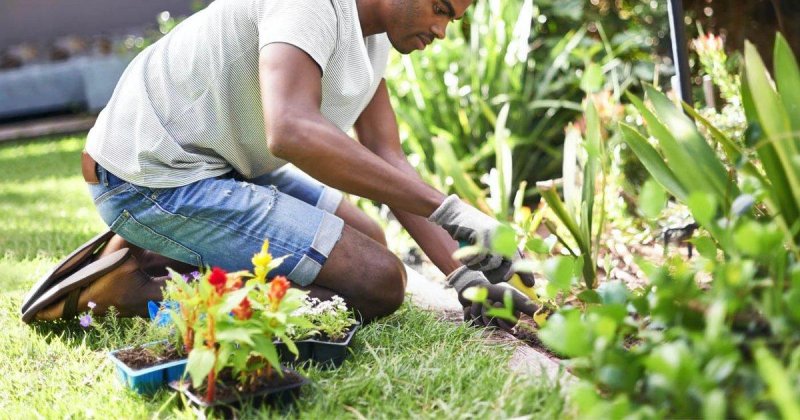
There’s a profound satisfaction that comes from plucking a sun-ripened tomato from your own vine, snipping fresh herbs for dinner, or admiring a vibrant bloom you nurtured from seed. Gardening, far from being just a hobby, is a deeply rewarding endeavor that nourishes the body, mind, and spirit. It offers fresh, healthy produce, a connection to nature, stress relief, and a tangible sense of accomplishment. While the idea of starting a garden might seem daunting, it's a journey accessible to anyone, regardless of their experience or outdoor space.
This ultimate guide will demystify the process, breaking down each essential step to help you cultivate your very own green oasis, from planning to bountiful harvest.
I. The Vision Quest: Defining Your Garden's Purpose
Before you dig your first hole, take a moment to dream. What do you want your garden to be?
- Edible Enthusiast? Do you envision a bounty of vegetables and herbs to supplement your kitchen? Are you aiming for self-sufficiency in certain crops, or just an occasional fresh treat?
- Floral Fantasy? Perhaps you yearn for a riot of colorful flowers to attract pollinators, adorn your home, or simply beautify your surroundings.
- Serene Sanctuary? Your goal might be a tranquil space for relaxation, meditation, or simply quiet contemplation amidst greenery.
- A Mix of Everything? Many successful gardens blend edibles, ornamentals, and native plants for a holistic ecosystem.
Your purpose will significantly influence your plant choices, layout, and maintenance approach. Be realistic about the time and effort you can commit. Starting small and expanding as your confidence grows is always a wise strategy.
II. Location, Location, Location: Site Selection is Key
The single most critical factor for a successful garden is sunlight. Most vegetables and many flowering plants need a minimum of 6-8 hours of direct sunlight per day. Herbs can often thrive with 4-6 hours, while some leafy greens and root vegetables may tolerate partial shade (3-4 hours).
- Sunlight Mapping: Spend a day observing your potential garden spots. Note where and when the sun hits different areas. Tall trees, fences, or buildings can cast significant shadows throughout the day.
- Water Access: Your garden will need consistent watering, especially during dry spells. Is your chosen spot conveniently located near a hose bib or another water source? Hauling buckets across a large yard quickly loses its charm.
- Drainage: Good drainage is essential. Avoid low-lying areas where water tends to collect after rain, as this can lead to root rot. If your soil is heavy clay, consider raised beds or amending significantly.
- Wind Protection: Strong winds can damage delicate plants, especially seedlings. If your site is exposed, consider natural windbreaks like fences, shrubs, or the side of your house.
- Proximity to Home: A garden closer to your house is more likely to be tended to regularly, making weeding, watering, and harvesting much more convenient.
III. The Foundation: Preparing Your Soil
Soil is the bedrock of your garden. Healthy soil provides the necessary nutrients, aeration, and water retention for robust plant growth.
- Soil Testing: Don't Skip This Step! A basic soil test (available at garden centers or through your local agricultural extension office) will tell you your soil's pH level and nutrient deficiencies. This eliminates guesswork and prevents you from adding unnecessary amendments.
- The Power of Organic Matter: Regardless of your soil type, adding ample organic matter is the single best thing you can do. Compost (homemade or bagged), well-rotted manure, leaf mold, and coir improve drainage in heavy clay, boost water retention in sandy soils, and provide a slow-release source of nutrients.
- To Dig or Not to Dig?
- Traditional Digging: Involves turning the soil to incorporate amendments and break up compacted layers. This can be hard work but is effective for severely compacted areas.
- No-Dig Gardening: A popular method that involves layering organic materials (cardboard, compost, leaves, straw) directly on top of existing soil or grass. This builds healthy soil over time, promotes beneficial soil organisms, and significantly reduces weeding. It's an excellent option for beginners.
- Raised Beds: These are fantastic for beginners and experienced gardeners alike. They offer excellent drainage, allow you to control the soil mix entirely, warm up faster in spring, and reduce bending. You can fill them with a mix of topsoil and compost.
- Container Gardening: For small spaces like balconies, patios, or even windowsills, containers are your answer. Choose pots with drainage holes and use a high-quality potting mix, not garden soil, which can compact and drain poorly in containers.
IV. Choosing Your Cast: What to Plant
Now for the fun part: selecting your plants!
- Start with Easy Wins: For your first garden, choose varieties known for their reliability and ease of growth.
- Vegetables: Lettuce, spinach, radishes, bush beans, snap peas, carrots (in loose soil), zucchini, cherry tomatoes (require support), bell peppers.
- Herbs: Basil, mint, chives, parsley, oregano, rosemary.
- Flowers: Marigolds, zinnias, cosmos, sunflowers, nasturtiums (edible flowers!).
- Know Your Climate Zone: The USDA Plant Hardiness Zone Map helps determine which plants can survive your local winter temperatures. This is especially important for perennials.
- Sunlight Requirements: Double-check the sun needs for each plant you choose to ensure they match your garden's sun exposure.
- Space Management: Read seed packets or plant tags for mature plant size and spacing recommendations. Overcrowding leads to poor air circulation, increased disease, and reduced yields.
- Succession Planting: Consider planting small batches of quick-growing crops (like lettuce or radishes) every few weeks to ensure a continuous harvest rather than one massive flush.
V. Getting Your Hands Dirty: Planting Methods
You have two main options for getting plants into your garden:
- Starting from Seeds:
- Pros: Much cheaper, wider variety of cultivars, satisfying to watch from the very beginning.
- Cons: Requires more time, specific indoor conditions (light, temperature, humidity) for early starts, and patience.
- Direct Sowing: Some seeds (like carrots, radishes, beans, peas, corn, squash) prefer to be sown directly into the garden bed once the soil warms up. Follow packet instructions for depth and spacing.
- Buying Transplants (Starts):
- Pros: Quicker gratification, higher success rate for beginners, bypasses the indoor seed-starting phase.
- Cons: More expensive, limited variety compared to seeds.
- Look for healthy, compact plants with good color and no signs of pests or disease. Avoid leggy or root-bound plants.
- Hardening Off: If you start seeds indoors or buy young transplants grown in a greenhouse, they'll need to be "hardened off" before planting outdoors. This means gradually exposing them to outdoor conditions (sun, wind, cooler temperatures) over a week or two to prevent shock. Start with a few hours in a sheltered spot, increasing exposure daily until they can stay out overnight.
VI. Nurturing Your Green Babies: Ongoing Care
Once your plants are in the ground, consistent care is paramount for a flourishing garden.
- Watering Wisely:
- Consistency: Plants need consistent moisture, especially during establishment and fruiting.
- Deep and Infrequent: It's better to water deeply and less frequently than shallowly and often. Deep watering encourages roots to grow deeper, making plants more resilient to drought.
- Timing: Water in the morning to allow foliage to dry before nightfall, reducing fungal diseases.
- Mulch: A layer of organic mulch (straw, shredded leaves, wood chips, compost) around your plants is a game-changer. It conserves soil moisture, suppresses weeds, regulates soil temperature, and slowly adds nutrients as it breaks down.
- Weeding: Weeds compete with your plants for water, nutrients, and sunlight.
- Early Intervention: The easiest time to remove weeds is when they're small.
- Hand-Pulling: Often the most effective method for small weeds.
- Hoeing: For larger areas, a hoe can be efficient.
- Mulch: As mentioned, mulch is your best friend for weed suppression.
- Feeding Your Plants: If your initial soil test showed deficiencies or if plants look stressed, you might need to fertilize.
- Organic Options: Compost tea, fish emulsion, worm castings, or organic granular fertilizers provide nutrients gently.
- Follow Directions: Over-fertilizing can harm plants.
- Pest and Disease Management:
- Observation: Regularly inspect your plants for signs of trouble (discolored leaves, holes, wilting, visible pests). Early detection is key.
- Healthy Plants are Resilient: Proper watering, good soil, and adequate sunlight create strong plants less susceptible to problems.
- Organic Solutions First: Hand-picking larger pests, rinsing aphids with a strong stream of water, using insecticidal soap for soft-bodied insects, or introducing beneficial insects.
- Good Air Circulation: Space plants appropriately to allow airflow, which helps prevent fungal diseases.
- Support Structures: Many plants, especially vining vegetables like tomatoes, cucumbers, and pole beans, will benefit from trellises, cages, or stakes to keep them off the ground, improve air circulation, and make harvesting easier.
VII. The Sweet Reward: Harvesting Your Bounty
Knowing when and how to harvest is crucial for maximum yield and flavor.
- Follow Guidance: Seed packets and online resources offer specific cues for ripeness for each vegetable (e.g., tomato color, cucumber size, lettuce leaf tenderness).
- Gentle Handling: Use sharp pruners or scissors for clean cuts to avoid damaging the plant.
- Regular Harvesting: Many crops, like beans, zucchini, and leafy greens, will produce more if you harvest regularly. This signals the plant to continue producing flowers and fruit.
VIII. Learning and Adapting: The Gardener's Journey
Gardening is a continuous learning process. Not every seed will sprout, not every plant will thrive, and pests will inevitably make an appearance. Don't be discouraged!
- Embrace Imperfection: Learn from your setbacks. Did a plant get too much sun? Not enough water? Was the soil too compacted?
- Observe and Adjust: Pay attention to how your plants respond to your care and the environment. Keep a simple garden journal to track planting dates, successes, and challenges.
- Connect with Others: Join local gardening groups, visit community gardens, or follow experienced gardeners online. Sharing knowledge is part of the joy.
Starting your own garden is an incredibly rewarding adventure. It connects you to your food, to nature, and to a vibrant community of passionate growers. Begin small, enjoy the fresh air, celebrate every sprout, and soon you'll be savoring the literal fruits of your labor – a delicious, healthy, and deeply satisfying harvest from your very own plot of earth. Happy gardening!







0 Comments
Post Comment
You will need to Login or Register to comment on this post!